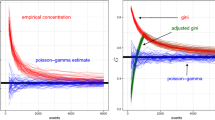Abstract
This article introduces the use of regression models based on the Poissondistribution as a tool for resolving common problems in analyzing aggregatecrime rates. When the population size of an aggregate unit is small relativeto the offense rate, crime rates must be computed from a small number ofoffenses. Such data are ill-suited to least-squares analysis. Poisson-basedregression models of counts of offenses are preferable because they arebuilt on assumptions about error distributions that are consistent withthe nature of event counts. A simple elaboration transforms the Poissonmodel of offense counts to a model of per capita offense rates. Todemonstrate the use and advantages of this method, this article presentsanalyses of juvenile arrest rates for robbery in 264 nonmetropolitancounties in four states. The negative binomial variant of Poisson regressioneffectively resolved difficulties that arise in ordinary least-squaresanalyses.
Similar content being viewed by others
REFERENCES
Bailey, A. J., Sargent, J. D., Goodman, D. C., Freeman, J., and Brown, M. J. (1994). Poisoned landscapes: The epidemiology of environmental lead exposure in Massachusetts. Soc. Sci. Med. 39: 757–766.
Bryk, A. S., and Raudenbush, S. W. (1992). Hierarchical Linear Models: Applications and Data Analysis Methods, Sage, Newbury Park, CA.
Bryk, A. S., Raudenbush, S. W., and Congdon, R. (1996). HLM: Hierarchical Linear and Nonlinear Modeling with the HLM/2L and HLM/3L Programs, Scientific Software International, Chicago.
Cameron, A. C., and Trivedi, P. K. (1998). Regression Analysis of Count Data, Cambridge University Press, Cambridge.
Gardner, W., Mulvey, E. P., and Shaw, E. C. (1995). Regression analyses of counts and rates: Poisson, overdispersed Poisson, and negative binomial. Psychol. Bull. 118: 392–405.
Greenberg, D. F. (1991). Modeling criminal careers. Criminology 29: 17–46.
Greene, W. H. (1995). LIMDEP: Version 7.0 Users Manual, Econometric Software, Plainview, NY.
King, G. (1989). Unifying Political Methodology: The Likelihood Theory of Statistical Inference, Cambridge University Press, Cambridge.
Liao, T. F. (1994). Interpreting Probability Models: Logit, Probit, and Other Generalized Linear Models, Sage University Paper Series on Quantitative Applications in the Social Sciences, 07-101, Sage, Newbury Park, CA.
Maltz, M. D. (1994). Operations research in studying crime and justice: Its history and accomplishments. In Pollock, S. M., Rothkopf, M. H., and Barnett, A. (eds.), Operations Research and the Public Sector, Volume 6 of Handbooks in Operations Research and Management Science, North-Holland, Amsterdam, pp. 200–262.
McClendon, McK. J. (1994). Multiple Regression and Causal Analysis, F. E. Peacock, Itasca, IL.
McCullagh, P., and Nelder, J. A. (1989). Generalized Linear Models, 2nd ed., Chapman and Hall, London.
Nagin, D. S., and Land, K. C. (1993). Age, criminal careers, and population heterogeneity: Specification and estimation of a nonparametric, mixed Poisson model. Criminology 31: 327–362.
Osgood, D. W., and Chambers, J. M. (2000). Social disorganization outside the metropolis: An analysis of rural youth violence. Criminology 38: 81–115.
Rowe, D. C., Osgood, D. W., and Nicewander, W. A. (1990). A latent trait approach to unifying criminal careers. Criminology 28: 237–270.
Sampson, R. J., Raudenbush, S. W., and Earls, F. (1997). Neighborhoods and violent crime: A multilevel study of collective efficacy. Science 177: 918–924.
United States Department of Commerce (1992). Summary Tape Files 1 and 3, 1990 Census.
Warner, B. D., and Pierce, G. L. (1993). Reexamining social disorganization theory using calls to the police as a measure of crime. Criminology 31: 493–517.
Author information
Authors and Affiliations
Rights and permissions
About this article
Cite this article
Osgood, D.W. Poisson-Based Regression Analysis of Aggregate Crime Rates. Journal of Quantitative Criminology 16, 21–43 (2000). https://doi.org/10.1023/A:1007521427059
Issue Date:
DOI: https://doi.org/10.1023/A:1007521427059



